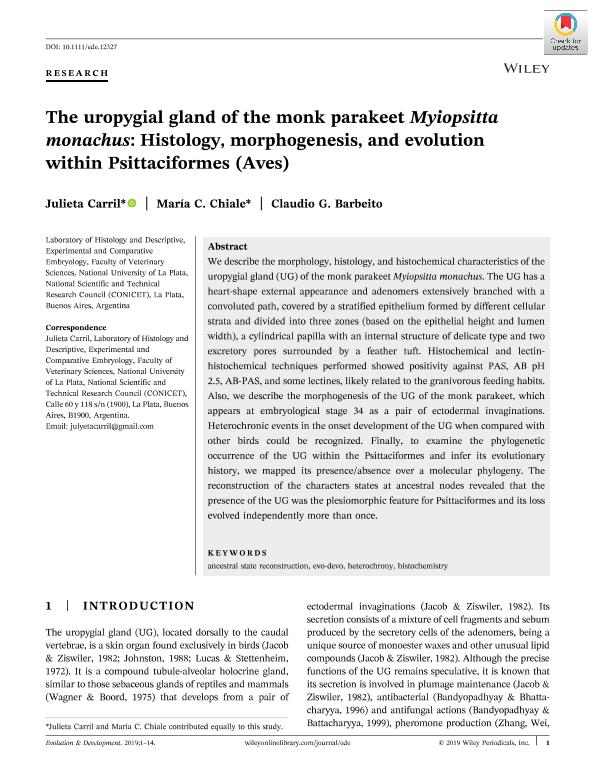Artículo
The uropygial gland of the monk parakeet Myiopsitta monachus: Histology, morphogenesis, and evolution within Psittaciformes (Aves)
Fecha de publicación:
04/11/2019
Editorial:
Wiley Blackwell Publishing, Inc
Revista:
Evolution & Development
e-ISSN:
1525-142X
Idioma:
Inglés
Tipo de recurso:
Artículo publicado
Clasificación temática:
Resumen
We describe the morphology, histology, and histochemical characteristics of the uropygial gland (UG) of the monk parakeet Myiopsitta monachus. The UG has a heart-shape external appearance and adenomers extensively branched with a convoluted path, covered by a stratified epithelium formed by different cellular strata and divided into three zones (based on the epithelial height and lumen width), a cylindrical papilla with an internal structure of delicate type and two excretory pores surrounded by a feather tuft. Histochemical and lectin-histochemical techniques performed showed positivity against PAS, AB pH 2.5, AB-PAS, and some lectines, likely related to the granivorous feeding habits. Also, we describe the morphogenesis of the UG of the monk parakeet, which appears at embryological stage 34 as a pair of ectodermal invaginations. Heterochronic events in the onset development of the UG when compared with other birds could be recognized. Finally, to examine the phylogenetic occurrence of the UG within the Psittaciformes and infer its evolutionary history, we mapped its presence/absence over a molecular phylogeny. The reconstruction of the characters states at ancestral nodes revealed that the presence of the UG was the plesiomorphic feature for Psittaciformes and its loss evolved independently more than once.
Palabras clave:
ANCESTRAL STATE RECONSTRUCTION
,
EVO-DEVO
,
HETEROCHRONY
,
HISTOCHEMISTRY
Archivos asociados
Licencia
Identificadores
Colecciones
Articulos(CCT - LA PLATA)
Articulos de CTRO.CIENTIFICO TECNOL.CONICET - LA PLATA
Articulos de CTRO.CIENTIFICO TECNOL.CONICET - LA PLATA
Citación
Carril, Julieta; Chiale, Maria Cecilia; Barbeito, Claudio Gustavo; The uropygial gland of the monk parakeet Myiopsitta monachus: Histology, morphogenesis, and evolution within Psittaciformes (Aves); Wiley Blackwell Publishing, Inc; Evolution & Development; 22; 3; 4-11-2019; 269-282
Compartir
Altmétricas




